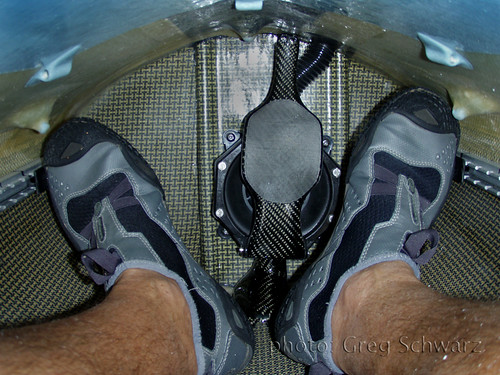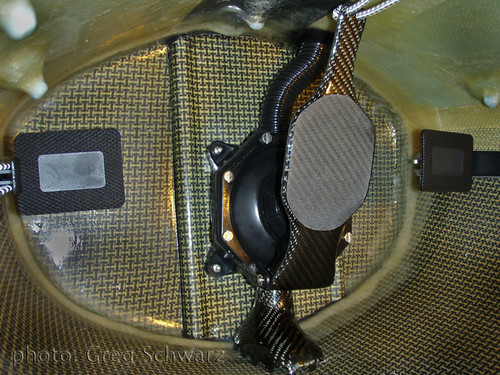One of my favorite aspects of sea kayaking is that I can travel under my own steam to remote places.
Often to reach pristine beaches I need to paddle for several days.
I am not interested in staying in resorts on my trips and camping from a kayak is the obvious solution.
I was a backpacker before becoming a kayaker and I learned to pack light and efficiently.
I can go away for a weekend in my kayak and fit all of my kit in one hatch and still have a lot of spare room.
Other kayakers are often amazed at how light my kayak is on a camping trip.
How do you do it? they ask me.
Well, I travel light, is my answer.
Travelling light means packing only really necessary items and/or using the lightest and most compact gear that fits the purpose.
If your camping experiences are limited at once a year affair it makes no sense to invest in light gear.
Light and compact gear usually costs a lot more than generic camping gear.
There are some real weight and size savings to be done with some of the most common camping items.
I have mentioned (in a previous post) that occasionally I like to take the bear minimum gear but here I would rather look at just one item of the kit: the sleeping mat.

Often to reach pristine beaches I need to paddle for several days.
I am not interested in staying in resorts on my trips and camping from a kayak is the obvious solution.
I was a backpacker before becoming a kayaker and I learned to pack light and efficiently.
I can go away for a weekend in my kayak and fit all of my kit in one hatch and still have a lot of spare room.
Other kayakers are often amazed at how light my kayak is on a camping trip.
How do you do it? they ask me.
Well, I travel light, is my answer.
Travelling light means packing only really necessary items and/or using the lightest and most compact gear that fits the purpose.
If your camping experiences are limited at once a year affair it makes no sense to invest in light gear.
Light and compact gear usually costs a lot more than generic camping gear.
There are some real weight and size savings to be done with some of the most common camping items.
I have mentioned (in a previous post) that occasionally I like to take the bear minimum gear but here I would rather look at just one item of the kit: the sleeping mat.

ultralight sleeping mats, a bit less comfortable...
A sleeping mat is an essential item for me. Without one I sleep badly being uncomfortable and cold.
Without proper rest my body suffers and I don’t paddle or hike properly the next day.
Unfortunately often a sleeping mat to be comfortable can be heavy and bulky. But not always.
Let’s take 3 types of sleeping mats: the self inflating one, the closed cell foam one and the air mattress.
I dislike the closed cell foam ones: too bulky and not enough cush for my liking.
I dislike the air mattress if it comes in the shape of a conventional car camping type (li-lo).
I like the self inflating ones. I also like air mattresses if properly engineered.
For this review I have used 3 mats that offer great comfort and similar in size when inflated (the Camplite slightly wider and longer however thinner).
All 3 mats are regarded as light and compact, in their class. I have not included generic type self inflating mats since they are often too bulky for the limited comfort they offer.
.jpg)
.jpg)
NeoAir 6.3 cm, Downmat 7 cm, Camplite 3.5 cm
The self inflating ones:
I purchased my first Thermarest in 1988 and immediately loved it.
It was a marked improvement over the closed cell foam.
Despite being a bit bulky and heavy I used it a lot. I eventually got an additional one in ¾ length because it was lighter and more compact: my feet could rest on my backpack if needed (cold ground). So far I have owned probably 14 Thermarest. I have upgraded throughout the years as they became more compact and lighter. I have also bought some generic brand ones but I have regretted buying each non Thermarest self inflating mat.
They just delaminated after a while.
I had one Thermarest (the very first ultra light ones) that was faulty but it was replaced on the spot without questions. I can not say the same for the generic brand ones!
The air mattress ones:
Years ago I tried to sleep on an air mattress. While in theory it should have given me a very cushioned rest I was very cold during the night.
In a common air mattress the movement of a person’s body will circulate the air that is cooled by the ground the mat is laying on.
In a very short time the sleeper will chill by the cold air under his/her body: a very uncomfortable result.
In the dead of the summer heat such feature might be desirable but any other time of the year it is not.
There are a couple of air mat manufacturers that have addressed this problem by filling the air chambers with light material to stop air circulating.
In the Exped mats there is synthetic or down as filler.
Thermarest has addressed the problem with creating very small baffled air chambers to stop the cold air moving around.
The advantages of the new Thermarest Neo Air mat are evident: compact, light and no pump needed for inflation (mouth inflation can destroy some fillers, like down).
In the picture below you can see that the Neo Air packs incredibly small despite being generous in size and thickness when inflated.
Despite being a bit bulky and heavy I used it a lot. I eventually got an additional one in ¾ length because it was lighter and more compact: my feet could rest on my backpack if needed (cold ground). So far I have owned probably 14 Thermarest. I have upgraded throughout the years as they became more compact and lighter. I have also bought some generic brand ones but I have regretted buying each non Thermarest self inflating mat.
They just delaminated after a while.
I had one Thermarest (the very first ultra light ones) that was faulty but it was replaced on the spot without questions. I can not say the same for the generic brand ones!
The air mattress ones:
Years ago I tried to sleep on an air mattress. While in theory it should have given me a very cushioned rest I was very cold during the night.
In a common air mattress the movement of a person’s body will circulate the air that is cooled by the ground the mat is laying on.
In a very short time the sleeper will chill by the cold air under his/her body: a very uncomfortable result.
In the dead of the summer heat such feature might be desirable but any other time of the year it is not.
There are a couple of air mat manufacturers that have addressed this problem by filling the air chambers with light material to stop air circulating.
In the Exped mats there is synthetic or down as filler.
Thermarest has addressed the problem with creating very small baffled air chambers to stop the cold air moving around.
The advantages of the new Thermarest Neo Air mat are evident: compact, light and no pump needed for inflation (mouth inflation can destroy some fillers, like down).
In the picture below you can see that the Neo Air packs incredibly small despite being generous in size and thickness when inflated.
I used a $50 bill for size comparison (greenback and OZ money, to cover all bases :-)
this top view really shows bulk savings:
NeoAir 410 g., Downmat7 880 g., Camplite 1220 g.
If your kayak is busting at the seams (no pun intended) maybe your sleeping mat could be reduced in size.
After all less is more.
(That’s not what she told me ;-)
After all less is more.
(That’s not what she told me ;-)

.jpg)
.jpg)
.jpg)

.jpg)
.jpg)
.jpg)


.jpg)
.jpg)
.jpg)
.jpg)
.jpg)
.jpg)
+.jpg)
.jpg)
.jpg)
.jpg)
.jpg)
.JPG)
.jpg)


.jpg)
.jpg)
.jpg)
.jpg)